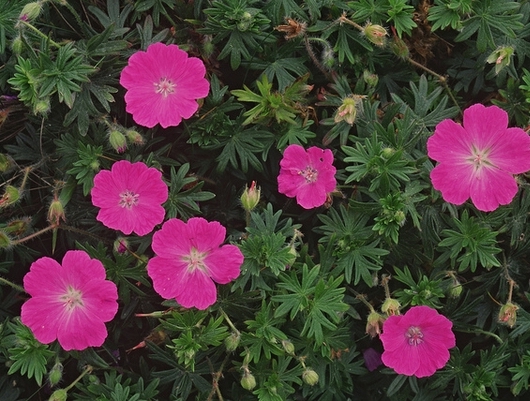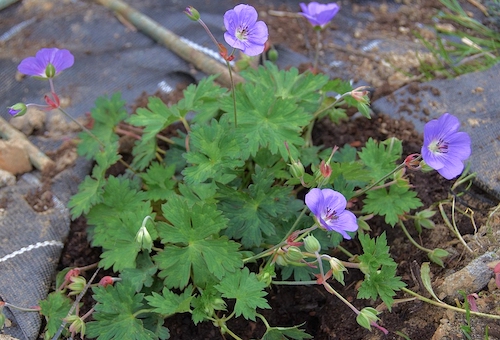Wild Geranium: An A-List Native
by Kathleen Curthoys, Fairfax Master Gardener
 If you’re looking for a native, shade-loving perennial that blooms profusely in spring, gets rave reviews from local pollinators and keeps going for an encore as a ground cover in summer, here’s an A-list choice for you: wild geranium (Geranium maculatum).
If you’re looking for a native, shade-loving perennial that blooms profusely in spring, gets rave reviews from local pollinators and keeps going for an encore as a ground cover in summer, here’s an A-list choice for you: wild geranium (Geranium maculatum).
This hardy woodland performer in the Geraniaceae family is native to Virginia and much of the eastern United States. This low-maintenance deciduous perennial grows in a mound shape about 2 feet tall and can thrive in a variety of garden settings. Wild geranium is at home in shady borders, native plant gardens, children’s gardens or the edges of woodland.
Wild geranium is known by several common names such as alum root, alum bloom, cranesbill, spotted cranesbill, wild cranesbill, spotted geranium and wood geranium. Its genus name comes from the Greek word “geranos,” meaning “crane,” referring to its fruit that is said to look like the head and beak of a crane. “Maculatum” means “spotted.” This plant should not be confused with the annual sun-loving dazzler also called “geranium” that has big blooms in often vivid colors. It is from the same family though a different genus, Pelargonium, which, by the way, is toxic.
The blooms last for about six to eight weeks, from April to June, and possibly longer in cool weather. Clusters of upward-facing blooms may be pinkish purple, lavender, blue-purple or rarely white, with fine veins said to mark the way to the nectar. The 1- to 1.5-inch wide (3 to 4 cm) flowers have five petals, several green sepals and yellow stamens. Flower buds are set the year before in a bud at the tip of the rhizomes.

Geranium ‘Rozanne’
The rhizomes produce a cluster of basal leaves and upright flowering stems. The palmately lobed basal leaves come out in spring with long petioles, coarse teeth and white hairs. The broad leaves are up to 6 inches (15 cm) across with five deep lobes. The stem leaves are smaller than the basal leaves with fewer lobes.
A few weeks after the plant has bloomed, distinctive fruit capsules will appear with a long appendage that looks like a crane’s head. The carpels of fruit will curl up and back, and when the fruit is ripe it will open to hurl the seeds 10 to 30 feet (3 to 9 m) from the plant.
Wild geranium is easily cultivated in the garden. It likes light shade to partial sunlight and tolerates full sun (defined as six hours or more per day) if it has enough moisture. Flowering is more abundant with more sunlight.
It does best in loamy, well-drained soil that is moist to slightly dry with plenty of organic matter. The soil pH can be slightly acid to neutral (6.0 or above).
This species will naturalize under optimum growing situations but is not considered invasive. It needs little maintenance, and since the plant doesn’t normally bloom again during the growing season, deadheading isn’t considered necessary. The foliage can be lightly sheared back and shaped after flowering. The leaves will stay green if there is enough moisture during the summer, but if the soil goes dry in the heat of summer, the foliage may turn yellow and decline.
Wild geranium’s rhizomes can spread by producing underground stems that grow out horizontally and produce roots and new shoots. The plant is propagated by dividing roots in early spring or fall. You can also start plants by seed you purchase or collect. To gather the seeds, take fruit as it begins to darken and store it in a paper bag to keep seeds contained when the fruit bursts open. Seeds can be sown outdoors in the fall.

Geranium ‘Espresso’
Once it blooms, the geranium attracts honeybees, bumblebees, butterflies, many types of native solitary bees, moths and syrphid flies, as well as ants, beetles and birds, which eat the ripening seeds. Deer may browse the flowers and occasionally the foliage, which generally tolerates the damage.
This plant has few pests, although aphids and slugs may infest it. Slugs and snails may want to snack on it. Rust and leaf spot may show up, but typically the plant has no serious disease problems.
Wild Geranium has been used by Native Americans as a remedy for a number of ailments, such as diarrhea, mouth problems and sores. Powdered forms have been used to treat wounds. Geranium has been applied topically to treat hemorrhoids and used externally for troubles involving pus, discharge and inflammations. It has also been used as an antiseptic and to control bleeding. Early American settlers used the plant to tan hides, since the wild geranium rhizome is rich in tannin.
There are a few varieties of wild geranium. ‘Album’ produces white flowers. ‘Elizabeth Ann’ has blue-lavender blooms and dark foliage. ‘Espresso’ is a chocolate-leafed variety with red-brown foliage and pale pink flowers.
Companion plants
Wild geranium may be seen growing in its native habitat frequently with these companions: ferns, bellwort (Uvularia grandiflora), bloodroot (Sanguinaria canadensis), Solomon’s seal, (Polygonatum spp.), false Solomon’s seal (Smilacina racemosa), Great while trillium, (Trillium grandiflorum) and woodland phlox (Phlox divaricata).
In your garden, consider planting it with these suggested companions: Celandine poppy (Stylophorum diphyllum), columbine (Aquilegia spp.), foam flower (Tiarella spp.), goat’s beard (Aruncus dioicus), and violas.
-
References
- Geranium maculatum, North Carolina State Extension
- Geranium maculatum, Sam W. Hitt, Medicinal Plant Gardens, University of North Carolina at Chapel Hill
- Wild Geranium, Geranium maculatum, Susan Mahr, University of Wisconsin – Madison Extension
- Wild Geranium, Geranium maculatum, Grow Native!, Missouri Prairie Foundation
- Geranium maculatum ‘Espresso’, Missouri Botanical Garden